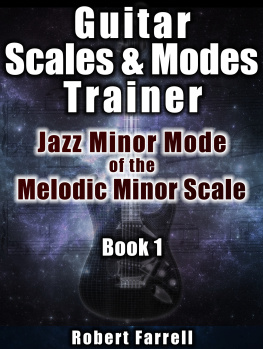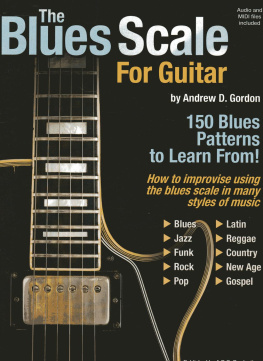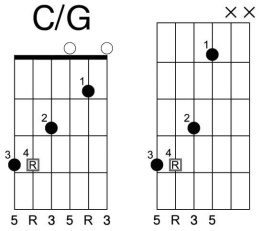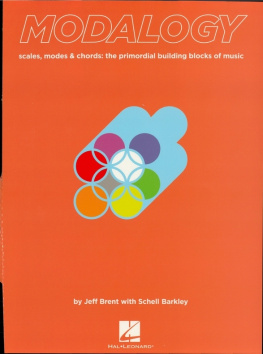Contents
Guitar Scales & Modes Trainer
A Systematic Approach to Supercharge your Technique
Jazz Minor Mode of the Melodic Minor Scale
Published by Robert Farrell at Smashwords
Copyright 2015 Robert Farrell
Smashwords Edition, License Notes
This e-book is licensed for your personal enjoyment only. This e-book may not be re-sold or given away to other people. If you would like to share this book with another person, please purchase an additional copy for each recipient. If youre reading this book and did not purchase it, or it was not purchased for your use only, then please return to your favorite e-book retailer and purchase your own copy. Thank you for respecting the hard work of this author.
About the Book
This book focuses specifically on the Jazz Minor mode of the melodic minor scale in its primary fret board position. This is the first mode of the melodic minor scale. In order to help you to learn and memorize this specific mode position, a total of 72 lesson exercises are provided with music and tablature notation, and fret board fingerings. The lesson exercises include:
- Mode Sequences : All seven mode sequences are provided within this specific position.
- Melodic Sequences : Three and four-note ascending and descending lesson exercises in two challenging variations.
- Melodic Intervals : Seven ascending and descending lesson exercises in two challenging variations. This includes 2nds, 3rds, 4ths, 5ths, 6ths, 7ths, and Octaves.
- Melodic Arpeggio Sequences : Three and four-note ascending and descending lesson exercises in two challenging variations. This includes triad, sixths, and sevenths arpeggio sequences.
- Melodic Arpeggios : Three and four-note ascending and descending full arpeggio lesson exercises. This includes triad, sixths, and sevenths arpeggios.
For those of you who are seeking to advance your technique with arpeggios even further, the Guitar Sweep Picking Trainer series is available and uses a systematic, comprehensive, pattern-based approach for developing the technique.
What Is the Systematic Approach?
This book is part of a series designed to help you learn and memorize the jazz melodic minor scale and modes by focusing on each mode position individually, then gradually connecting them together to cover every position of the fret board. Each mode position is explored in depth to gradually develop your technique using scalar melodic sequences, intervals, and arpeggios. For every exercise, music and tablature notation are provided, as well as recommended fret board fingerings.
Each book focuses on a single fret board position that is primarily associated with that mode. The ascending and descending sequence is introduced to establish the sound and feel of the complete position of that mode. Additionally, the other mode sequences within the position are introduced in order to develop the ability to transition the mode without entirely changing the position.
Three and four-note melodic sequences further develop and solidify an understanding of that mode. Each ascending and descending melodic sequence provides two challenging variations which develops technique and continues expanding awareness and memory of the position.
Melodic intervals introduce another powerful method to develop technique and improve memorization in a non-linear way. They are the building blocks for unlocking arpeggios in the position. Seven ascending and descending melodic intervals are introduced in two challenging variations to minimize any pattern preferences that could develop.
Arpeggio sequences are an amazing method to enhance melodic technique and expand awareness of fret board patterns and note groupings within the position. Three and four-note ascending and descending arpeggio sequences are introduced in two challenging variations to ensure maximum development, awareness, and memorization of the melodic possibilities within the position. This includes triad, sixths, and sevenths arpeggio sequences.
Lastly, complete melodic arpeggios can unlock the full, melodic potential of the position in many new ways. All ascending and descending triad, sixths, and sevenths arpeggios are introduced to establish a deep, solid, foundation for melodic technique and positional understanding.
Overall, these combined elements are designed to provide a systemic method that can help you to practice and improve consistently in as little as an hour a day.
Who Is This Book For?
This book is for beginning, casual, novice, intermediate, and advanced guitarists. The lessons in this book are designed to help you learn, understand, and memorize this specific scale position quickly, easily, and efficiently, as well as simultaneously develop, strengthen, and improve your technique. Each practice lesson can be accomplished in as little as one hour a day.
This systematic approach is especially important because instead of a multitude of scale position diagrams, we study this specific scale position in the context of melodic sequences, intervals, and arpeggios. As we study and practice these melodic elements, we become increasingly aware of them and how they flow within this specific scale position. As a result of continued practice of these melodic elements, we ultimately end up memorizing the underlying scale position without any extra effort.
I believe the Guitar Scales & Modes Trainer can offer guitarists of all levels of experience the kinds of results to keep you motivated and excited about new possibilities for creative expression.
Melodic Minor Scale
The melodic minor scale has both an ascending and descending sequence. With respect to the major scale, the ascending sequence has a flat 3rd, and the descending sequence has a flat 3rd, 6th, and 7th. The descending sequence is identical to the Aeolian mode of the major scale. This book focuses specifically on the ascending sequence as is commonly used in jazz and is also known as the jazz melodic minor scale.
The C melodic minor scale consists of the notes C D Eb F G A B. Each note in sequence is associated with a respective degree, from I to VII. The first degree, C, is the root or key of the scale. The tonality of the melodic minor scale is centered around the first degree. If we were to build a three-note chord starting with each degree of the scale, it would have a specific quality. The following table contains this information.
C Melodic Minor Scale - Degrees & Triads
Degree Note Triad Quality
I C C Eb G Minor
II D D F A Minor
III Eb Eb G B Augmented
IV F F A C Major
V G G B D Major
VI A A C Eb Diminished
VII B B D F Diminished
.
Modes
The melodic minor scale contains seven modes. A mode of the melodic minor scale is a shift of the starting note in the scale sequence. The absolute sequence stays the same. Essentially, each mode represents a different scale within the melodic minor scale. The tonality of the mode is centered around the starting note. Even though the individual notes aren't changed, the relationships between notes are altered after changing the starting note.
Each mode has a name associated with the melodic minor scale degree that it is based on. Each note's degree remains based on its absolute position in the melodic minor scale.
For example, in the Dorian b2 mode of the melodic minor scale, the starting note is based on the second degree. The second degree of the C melodic minor scale is D. Even though D is the starting note, it is still considered the second degree of the melodic minor scale sequence. The following table contains this information for the C melodic minor scale.













